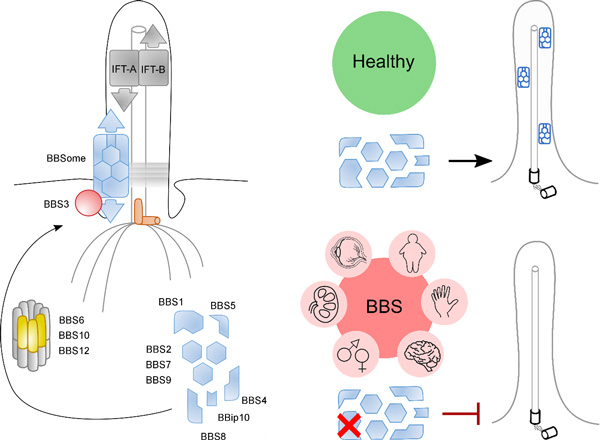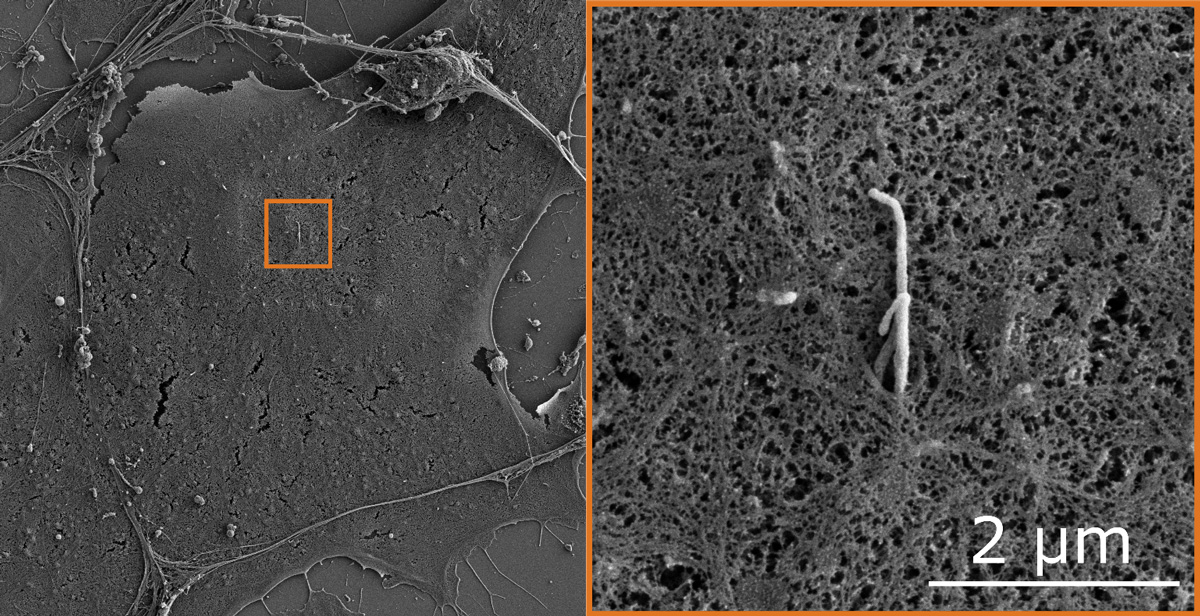Primary cilia dynamics and function in homeostasis and during disease
Primary cilia are microtubule-based membrane protrusions on the surface of all cells except of the cells of the hematopoietic origin. This once a vestigial organelle serves as a cellular signaling hub sensing environmental cues and thus is essential for organ development and function.
Primary cilium on the surface of mouse embryonic fibroblast (orange box left and zoom right) visualized using scanning electron microscopy. Scale bar, 2 µm.
Defects in primary cilia lead to pleiotropic human diseases – ciliopathies. Bardet-Biedl Syndrome (BBS) is caused by the dysfunctional ciliary cargo adaptor complex BBSome and presents with multiple phenotypes including obesity and anomalies in retina, kidneys, reproductive organs and cognitive behavior.

There are multiple signaling pathways associated with primary cilia, e.g. Sonic Hedgehog and Wnt, known to regulate diverse processes during organ development and regeneration. Primary cilia are very dynamic organelles. They grow and shrink and remove the membrane vesicles in an actin dependent manner during signal transduction and over the cell cycle.
Our Research
Our team focuses on how cilia and BBSome function in different tissues by studying the retina and kidney cells, bone marrow mesenchymal stem cells and embryonic fibroblasts. We employ the mouse models of BBS and work with BBS patient’s data.
The projects currently running are depicted here:
- Mechanisms of the BBS pathology seen through the BBS associated mutations.
- Regulators of the intraciliary actin polymerization and their role in ciliary signaling.
- Functional interplay between cilia, BBSome and Wnt signaling in the bone marrow niche.

Team Members

| Leader | Martina Huranová |
| Doctoral students | Avishek Prasai Olha Ivashchenko |
| Master student | Kristýna Mašková |
| Bachelor student | Sofiia Bykova |
Publications
2022
- : A protocol for generation and live-cell imaging analysis of primary cilia reporter cell lines. STAR Protoc 2022 3(1): 101199. [pubmed] [doi]
2021
- : Bardet-Biedl Syndrome ciliopathy is linked to altered hematopoiesis and dysregulated self-tolerance. EMBO Rep 2021, e50785. [pubmed] [doi]
2020
- : Prospects and limitations of expansion microscopy in chromatin ultrastructure determination. Chromosome Res 2020 28(3): 355-368. [pubmed] [doi]
- : The BBSome assembly is spatially controlled by BBS1 and BBS4 in human cells. J Biol Chem 2020. [pubmed] [doi]
2019
- Arakel EC, Huranova M, Estrada AF, Rau EM, Spang A, Schwappach B: Dissection of GTPase-activating proteins reveals functional asymmetry in the COPI coat of budding yeast. J Cell Sci 2019 132(16). [pubmed] [doi]
- Niederlova V, Modrak M, Tsyklauri O, Huranova M, Stepanek O: Meta-analysis of genotype-phenotype associations in Bardet-Biedl syndrome uncovers differences among causative genes. Hum Mutat 2019. [pubmed] [doi]

